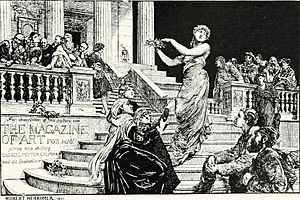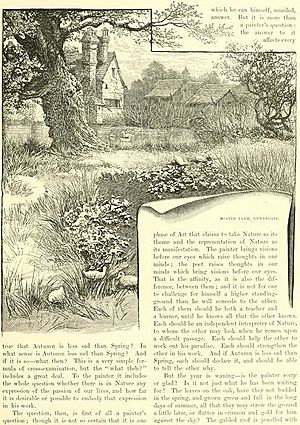The Magazine of Art facts for kids
Imagine a cool magazine all about art! That was The Magazine of Art. It was a monthly magazine from Britain that showed off amazing pictures and stories about art. It was published from May 1878 to July 1904 in London and New York City by a company called Cassell, Petter, Galpin & Co. Inside, you could find reviews of art shows, articles about artists, and all sorts of visual arts. It even had some poetry! The magazine was famous for its beautiful pictures, often made by top wood-engravers like William Biscombe Gardner.
Contents
The Magazine's Journey Through Time
The idea for The Magazine of Art actually started much earlier. In May 1851, the House of Cassell first published a journal about The Great Exhibition. This was a huge event in London that showed off new inventions and art.
Early Art Magazines
In 1852, this journal changed its name to The Illustrated Exhibitor and Magazine of Art. It came out every week and was meant to teach people about art. It wanted to bring "culture for the little cultured," meaning it was for everyone, not just art experts. In 1853, it changed its name again to The Illustrated Magazine of Art. However, it wasn't very popular and stopped being published in 1854. The magazine was briefly brought back for the 1862 International Exhibition but then disappeared until 1878.
The Magazine of Art Begins
The Magazine of Art as we know it started on April 25, 1878. This was the same year as a big world fair in Paris, called the Exposition Universelle. The first editor was Arthur J. R. Trendell, who worked on it until 1880.
After him, several other people took over as editor:
- Eric Robertson (1880–1881)
- William Ernest Henley (1881–1886)
- Sidney Galpin (1886)
- Marion Harry Spielmann (1886–1904)
Within just three years, the magazine became very well-known. It started including reviews of art shows. A famous artist named Hubert Herkomer even designed a special poster for the magazine. This poster showed the goddess of art with famous artists from history looking on, giving their approval.
A Magazine of High Quality
The publishers spent a lot of money to make the magazine look amazing. They saw it as the "flag of the house," meaning it was very important to their company. They wanted to interest both art lovers and art collectors. The magazine also made sure to share its own honest opinions about art.
One of the most interesting writers for the magazine was William W. Fenn. He had lost his sight, but he still wrote reviews! His wife would take him to art galleries and describe the artworks to him. This way, he could still share his thoughts with readers.
New Ideas and Influences
William Ernest Henley, who was editor from 1881 to 1886, really made the magazine exciting. He turned it into a "lively, worldwide review of the arts." He helped shape what people thought about art. He got famous artists and writers to contribute, like R. L. Stevenson and Richard Jefferies. The quality of the wood engravings (the pictures) also got even better during his time. He was also the one who started including poetry in the magazine.
Later Years and End of Publication
Marion Harry Spielmann was the editor for a long time, from 1886 to 1904. He encouraged many well-known artists and even the famous art critic John Ruskin to write articles. In 1888, the magazine added a special section called Royal Academy Pictures. This part showed pictures of the best artworks from the yearly Royal Academy exhibitions in London.
However, even with all its success, The Magazine of Art eventually stopped making enough money. So, it stopped being published in 1904. The Royal Academy Pictures supplement, however, continued until 1916.



